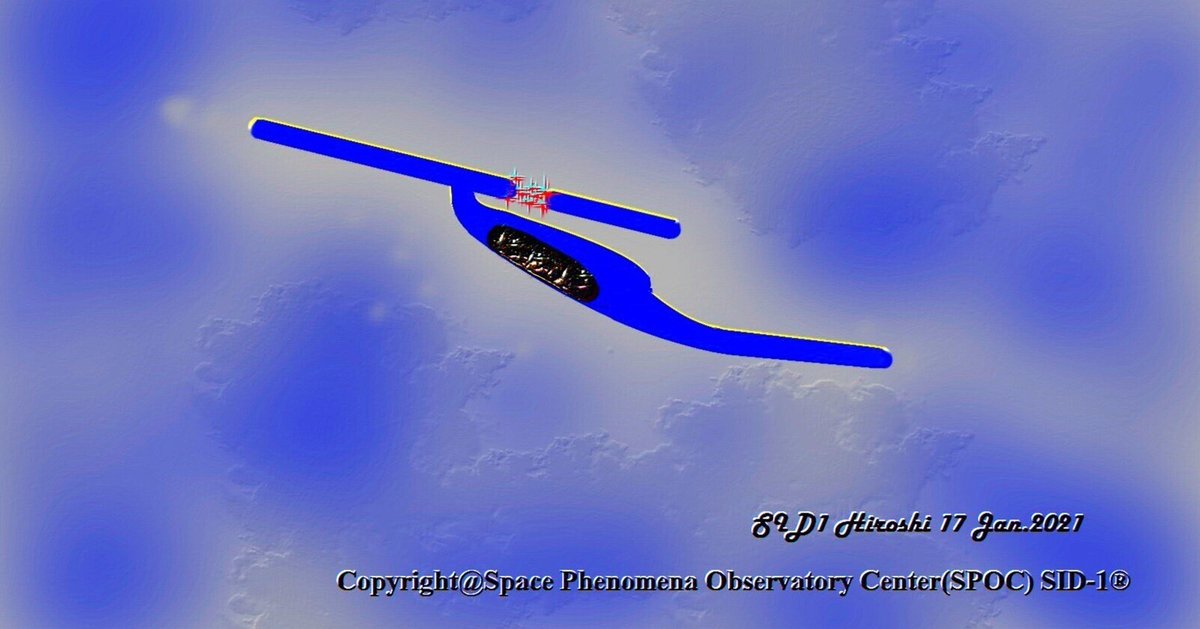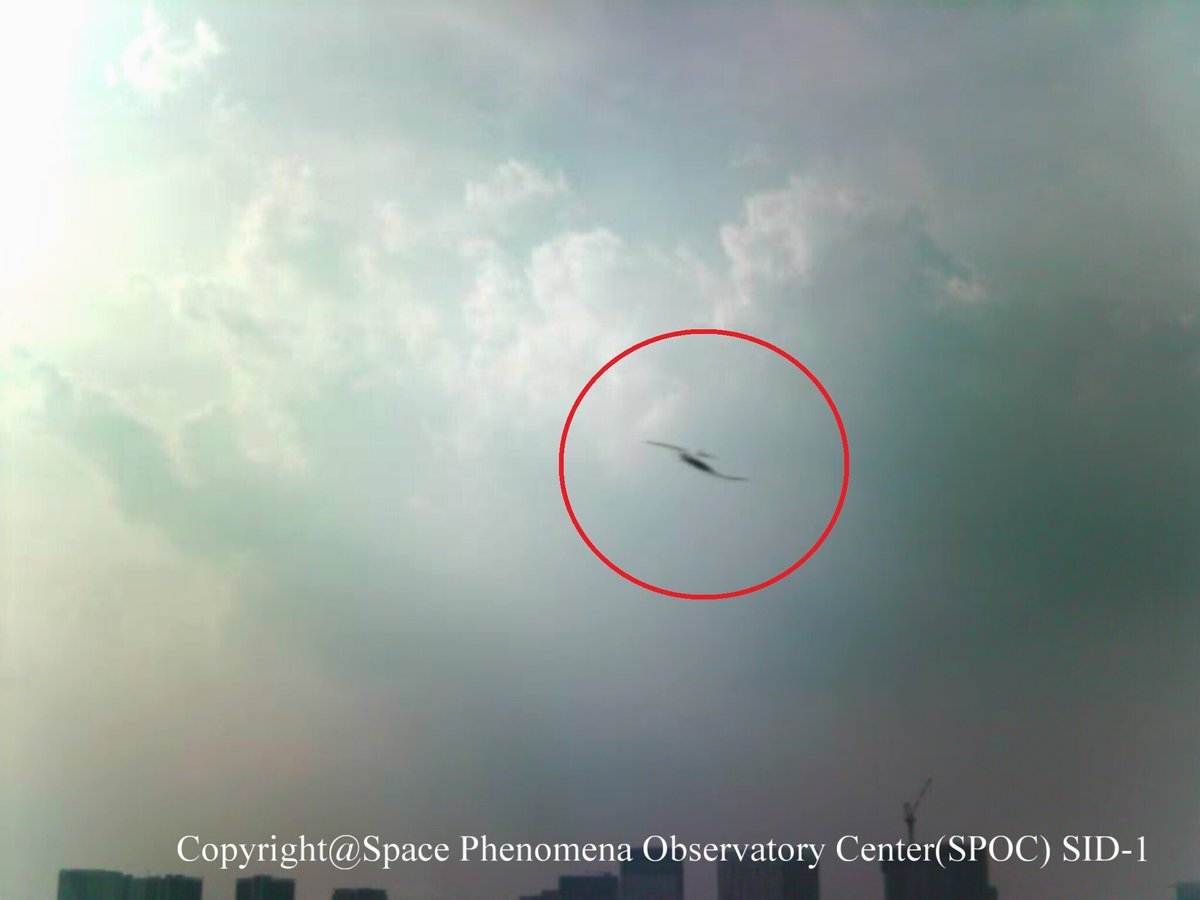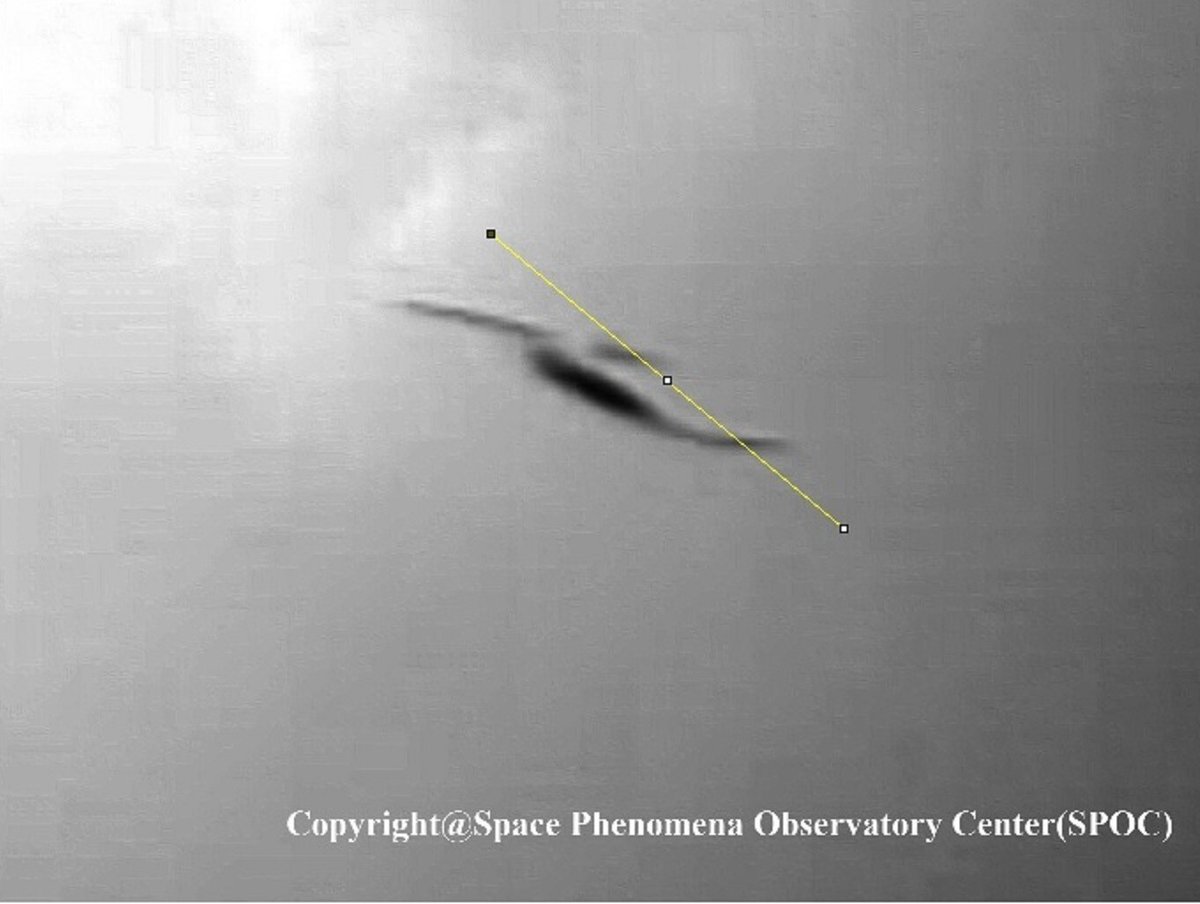
Never-before-seen and astonishingly odd-shaped UAP captured by SID-1!Mysterious UAP crossed the sky over Tokyo at very high speed!
Updated Nov.24,2023 by Kitajima Hiroshi, Space Phenomena Observatory Center (SPOC)
Supervisor: Kurosaki Akira, Special Advisor, Space Phenomena Observatory Center (SPOC), Former Professor, The University of Tokyo
Click here for UFO and UAP videos taken by the Space Phenomena Observatory Center (SPOC), https://www.youtube.com/channel/UCTqD750RqvlJ1Q0uYlDxSMQ/feed
Click here to view this UAPvideo.
SID-1 of the Space Phenomena Observatory Center (SPOC), which has been capturing various mysterious objects, captured startling images.
The SID-1 captured the sudden appearance of an oddly shaped UAP in a spectacular manner.
The first thing that surprises us when we look at the images is the shape of the UAP. The shape of the UAP is unlike anything that has ever been seen or reported before. (See video and images)
An image search of the shape of this image did not retrieve a similar shape.
Also, no birds flying in a similar form were found when compared to data on bird flight patterns.
Of course, it is not an airplane, helicopter, or Osprey.
It was captured by SID-1 at 16:04:56 on August 8, 2015. In two consecutive frames it was captured.
From this video, we can see that this UFO did not just look oddly shaped, but flew at an astonishing speed. Its specific estimated speed was revealed for the first time in the world.
The weather that day was clear, with no precipitation, the temperature was 29.8°C, and the wind speed was 5.3 m/s. The direction of the wind was east-northeast, and the first image of this object was taken in the west, from which it moved in a north-northeast direction.
In other words, the direction of movement of the object and the wind direction are approximately 180 degrees opposite, so it is never an object blown by the wind, or a balloon. (See figure ).






Astonishing ultra-high speed that is unthinkable by common sense
This UAP was captured in two consecutive frames.
Therefore, we determined the angular velocity (the angle moved in one second, calculated from the angle moved by the UAP in one frame of video captured by SID-1) from the image and calculated the velocity of this UAP using a simple trigonometric function.
The absolute distance was not known exactly, but the location and distance of the skyscrapers in the background were known. Also, based on the camera's focus, it was possible to estimate with a high degree of certainty that the range was approximately 1 to 5 kilometers.

Here is the result of my calculations.
Assuming a distance of 1 km, the speed could be calculated to be 31,482 km/h. That is an incredibly high speed.
This speed is about three times faster than that of Japan's ”Hayabusa”, the world's first spacecraft to successfully return samples from the asteroid ”Itokawa”.
The size of the object can be calculated to be 45 meters.
At a distance of 5 kilometers, the speed would be 157,412 kilometers per hour, four times the speed of the Apollo spacecraft.
This is four times the speed of the Apollo spacecraft. In this case, the size of the object would be 200 meters.
At the time, there were no reports of damage caused by shock waves, which would occur when flying at such extremely high speeds. It is also strange that the object does not appear to have been destroyed by aerodynamic heating caused by compressed air. Without some special mechanism, such as a heat shield, the object would have easily evaporated at temperatures exceeding tens of thousands of degrees Celsius. Strangely enough, this is not the case at all.
Or they may have traveled by a means of transportation that we are completely unaware of, and not through the air.
Incidentally, the sun, with its planets in tow, orbits the center of the galaxy at a speed of 70,000 kilometers per hour, and the earth orbits the sun at 100,000 kilometers per hour.
In any case, there can be no aircraft or fighter planes in Japan, since planes are prohibited from flying over cities at supersonic or higher speeds during normal times. (Incidentally, the supersonic speed of Mach 1 is 1234.8 km/h.)
For comparison, a video is taken of a normal passenger plane at a distance of almost 5 km.
The speed of a normal passenger plane landing and descending at Haneda Airport is about 250 to 300 km/h. At this distance, the aircraft will appear very slow.
Angular velocity will also be a very minute change. Of course, like normal video, all frames are shown continuously.



In comparison, the UAP is seen in only two consecutive frames, and nothing is seen in the frames before or after it. This shows how fast it moved.
Astonishingly odd-shaped UAP is one of the most remarkable images taken by SID-1®.
It is the world's first recorded UAP with a shape that can be described as a Knight with a spear, or an enemy space battleship from an American space adventure TV drama.
Fortunately, this time it was captured in a continuous frame and the distance of the background was clear, so we were able to guess the distance of that UAP to some extent.
This made it possible to compare the visibility with other aircraft flying at the same distance, but this time the difference in speed between the UAP and the other aircraft was a threat by a digit.
How far transcendent is this technology? It makes me think that they may have traveled by means of transportation that we know nothing about, and not through the air.


Image Analysis







From these images, we can see two things.
nothing exists between A and B. There is no connection.
there is a connection between A and C, but nothing exists between B and C.
This suggests that, as the illustration shows, B, curiously, is not connected to anywhere
but seems to form part of a variant UAP.
This UAP has the following characteristics
1 The fact that we captured a special, odd-shaped UAP
2 Ultra-fast movement by some method
3 The fact that it was captured in only two consecutive frames, with nothing before or after it
4 A special shape that has not been recorded in the past
5 Impossible peculiar structure that has not been integrated
It was the world's first, astonishing, atypical UAP captured like this.
We will continue to keep an eye on SID-1® at the Space Phenomena Observatory Center (SPOC).
SID-1 also cooperates in the search for extraterrestrial civilizations
The latest research in the search for extraterrestrial civilizations estimates that there are more than 100 million Earth-like planets in our own galaxy alone.
Furthermore, it is estimated that there are more than several trillion such galaxies in the entire universe.
If there are that many galaxies and a vast number of planets that could potentially support life like Earth, researchers are seriously considering the possibility of intelligent aliens like the various life forms on Earth.
Many researchers believe that extraterrestrial civilization exploration is the great quest it is for humanity as a whole.
Aliens are no longer a figment of the imagination, and now people and scientists around the world are seriously spending large budgets to search for extraterrestrial life.
Rapid advances in astronomical observational methods and technology have led to an explosion in the number of planets that are located in the habitable zone and are capable of harboring terrestrial life forms with the potential for liquid water.
Scientists are interested in extraterrestrial life, how to find and communicate with aliens, from whether they exist or not? This is about to become a huge movement.
Assuming that extraterrestrial intelligence has sent probes to the Earth's periphery, there are also scientific research fields that photograph and search the near-Earth, atmospheric, and aerial regions where they may be deployed.
SID-1 at our Space Phenomena Observatory Center (SPOC) is a case in point.
We hope it will be of assistance in scientific research.
Automatic Observation and Imaging Device Robot SID-1
At this very moment, SID-1 is continuing automatic observations with its "lens that never sleeps.
In addition to the cases introduced here, SID-1 has already observed several other mysterious phenomena and objects.
The Space Phenomena Observatory Center (SPOC) is the first of its kind in the world, established with the intention of actively supplementing and recording the various strange phenomena and objects occurring in space and in the air within the Earth's atmosphere, among them UFOs.
Since the start of observations, SID-1, an automatic observation and imaging device robot constructed by the Space Phenomena Observatory Center (SPOC), has automatically detected and recorded objects and phenomena moving in space and in the air, such as UAPs, mysterious lights, UFC, meteors, lightning, IFOs, etc., in addition to UFOs.
The SID-1 is mobile and can be installed anywhere in the world, and image analysis and analysis of the image data taken by the SID-1 is also performed using dedicated software.
Some of the images taken by SID-1 are available at the Space Phenomena Observatory Center.
Space Phenomena Observatory Center (SPOC)
